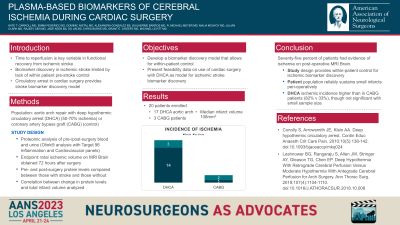Plasma-based biomarkers of cerebral ischemia during cardiac surgery
Plasma-based Biomarkers of Cerebral Ischemia During Cardiac Surgery
Friday, April 21, 2023

.jpg)
Kate Carroll, MD, MAS (she/her/hers)
Resident
University of Washington
Seattle, Washington, United States
ePoster Presenter(s)
Introduction: Acute ischemic stroke (AIS) is a leading cause of disability and mortality. It results in time-dependent neuronal death, making time to treatment critical to outcome. AIS is currently diagnosed via imaging, which can be time-intensive and costly. Efforts to identify diagnostic biomarkers for AIS have relied on comparisons between patients and healthy controls. Here we present a novel model for AIS biomarker discovery. Aortic arch repair with hypothermic circulatory arrest is associated with imaging evidence of AIS in 50-100% of patients, providing an opportunity for these patients to serve as their own controls.
Methods: Blood is collected from patients undergoing cardiothoracic surgery pre-anesthesia and at the end of surgery. We included patients undergoing aortic hemiarch repair, which requires hypothermic circulatory arrest, as well as coronary artery bypass graft (CABG), to serve as a control. Plasma and serum are isolated via centrifugation and stored at -80°C. Patients undergo magnetic resonance imaging (MRI) of the brain on post-operative day 3 and a neurologic exam is recorded after the MRI is obtained.
Results: Blood and post-operative MRIs were obtained from 17 hemiarch replacement patients and 4 CABG patients. Plasma samples were sent for Olink® analysis using the Target 96 Inflammation and Cardiovascular panels, which returns transcriptomic data for 192 proteins. MRI results demonstrate diffusion restriction in two of 4 CABG patients (50%) and 14 of 17 hemiarch patients (82%), for an overall rate of 76%. Only two patients had new focal neurologic deficits associated with their infarcts.
Conclusion : Patients undergoing aortic arch surgery present a unique and novel opportunity for AIS biomarker discovery. Three-quarters of our patients had AIS in the peri-operative period. By collecting patient samples prior to induction and at the end of surgery, this model allows patients to serve as their own controls in biomarker discovery.
Methods: Blood is collected from patients undergoing cardiothoracic surgery pre-anesthesia and at the end of surgery. We included patients undergoing aortic hemiarch repair, which requires hypothermic circulatory arrest, as well as coronary artery bypass graft (CABG), to serve as a control. Plasma and serum are isolated via centrifugation and stored at -80°C. Patients undergo magnetic resonance imaging (MRI) of the brain on post-operative day 3 and a neurologic exam is recorded after the MRI is obtained.
Results: Blood and post-operative MRIs were obtained from 17 hemiarch replacement patients and 4 CABG patients. Plasma samples were sent for Olink® analysis using the Target 96 Inflammation and Cardiovascular panels, which returns transcriptomic data for 192 proteins. MRI results demonstrate diffusion restriction in two of 4 CABG patients (50%) and 14 of 17 hemiarch patients (82%), for an overall rate of 76%. Only two patients had new focal neurologic deficits associated with their infarcts.
Conclusion : Patients undergoing aortic arch surgery present a unique and novel opportunity for AIS biomarker discovery. Three-quarters of our patients had AIS in the peri-operative period. By collecting patient samples prior to induction and at the end of surgery, this model allows patients to serve as their own controls in biomarker discovery.
